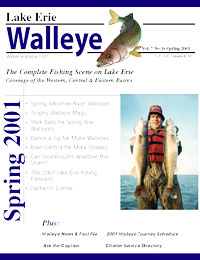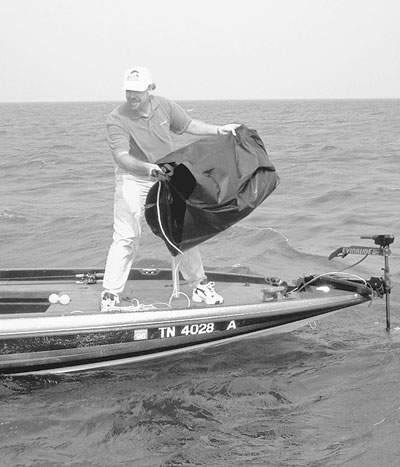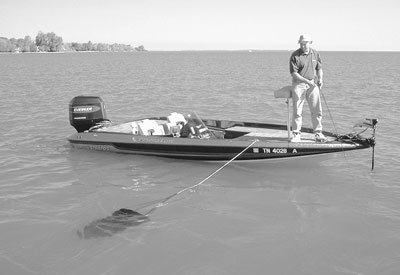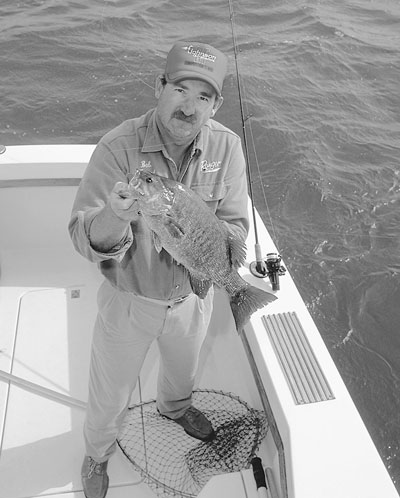Critical Boat Control
Produces
More Smallmouths
by Mark Hicks

Order Lake
Erie Walleye Magazine
Three Information-Packed Issues for only $10.00
Delivered to your doorstep every March, June and September
|
Critical Boat Control
Produces |
|
T
he vast, open expanses of Lake Erie, coupled with its extensive off shore smallmouth habitat, present special challenges to
anglers. Whether you fish from a bass boat or a 40-foot cruiser, many of the
same boat control principles apply.
to
anglers. Whether you fish from a bass boat or a 40-foot cruiser, many of the
same boat control principles apply.
Boat control separates consistently successful Lake Erie smallmouth anglers from those who often endure lackluster outings. Even if you determine where smallmouths are located and select the right lures or bait rigs, haphazard boat control drastically reduces your catch.
DRIFTING
When the wind kicks up, many Lake Erie bass anglers stay on shore to avoid rough boating and strenuous fishing conditions. While you should never venture out in truly dangerous weather, a stiff breeze frequently puts smallmouths on the feed. No fisherman is more in tune to this fact than Jeff Snyder, a career bass angler from Massillon, Ohio.
Snyder excels when the wind blows by using its power to his advantage. He relies heavily on the drift-and-drag system he continually refines. This method works well for all boats and is regularly employed by charter captains.
DRIFT & DRAG
Drifting may sound like an aimless approach, and it can be if done improperly, but Snyder doesn’t merely cast his fate to the wind. His controlled drifts allow him to make big catches in blustery weather. Snyder harnesses the wind to push his boat while he drags a lure (usually a jig) behind.
The drift-and-drag is, without question, the easiest and one of the most effective methods for taking Lake Erie smallmouth bass. Some of the best drift fishing occurs in the spring and fall when smallmouths move up and scatter over near shore bottom structures in depths from about 12 to 25 feet.
"Most guys concentrate on the tops of the rises," says Snyder, "but the majority of the feeding takes place on the deeper flats. Smallmouths constantly move up and down, so I constantly move too."
In summer and early fall, claims Snyder, smallmouths roam in small
clusters. He reasons that drifting increases his odds for en countering
different groups of fish at this time, because his lures cover expansive
areas. An ideal situation is a wind that blows along the length of a ridge,
bottom contour or drop-off, permitting long drifts up to a quarter of a mile
or more.
countering
different groups of fish at this time, because his lures cover expansive
areas. An ideal situation is a wind that blows along the length of a ridge,
bottom contour or drop-off, permitting long drifts up to a quarter of a mile
or more.
Snyder motors upwind of a likely smallmouth structure and positions his boat so the wind pushes him over the most promising portion of it. He wheels the outboard one way as far as possible, using it as a rudder to swing the bow toward the wind. The electric motor is then pointed into the wind and used to nudge the bow over so the boat drifts broadside to the breeze. Larger fishing vessels, more typical on Lake Erie, generally are not equipped with electric motors, but they perform well with the drift-and-drag.
"I try to drift parallel to the edge of a drop-off as much as I can," he says. "I strive to put the center of the boat right on the contour."
If the wind is much stronger than about 15 miles per hour, Snyder sets out a sea anchor, also known as a drift sock. The drift sock, an essential tool for the drift-and-drag, slows the boat when the wind kicks up. More often than not, you’ll benefit by using this device. Slower drift speeds allow for lighter jigs and more tempting lure presentations. Attach the drift sock to a cleat in the middle of the boat or up near the bow, whichever location better holds the boat broadside.
A 20-inch diameter drift sock does nicely with boats up to 20-feet in most winds. Larger boats require socks on the order of 40-inches in diameter. Under extremely windy conditions, put out two or more socks or expand an adjustable sock.
If Snyder’s initial drift doesn’t produce, he makes ensuing drifts shallower or deeper until he starts getting strikes. He then concentrates on the productive depth, making repeated drifts over the same contour or fishing other structures nearby.
"Let the boat do the work," he advises. "Just keep the lure in the water, dragging and skipping over the rocks. You’ll know when a bass nails it."
CAST AHEAD
OF THE DRIFT
You may effectively combine casting with drifting, as long as you cast
ahead of the boat to prevent line drag caused by the boat’s movement. Cast bottom hopping lures, such as jigs and jigging spoons,
with the wind. Let them sink to the bottom before working them back. A fast
drift forces you to fish with an upbeat pace, which is fine when bass are
aggressive. When bass want a slower presentation, you’ll have to slow the
drift with a drift sock or go with the drift-and-drag routine.
boat’s movement. Cast bottom hopping lures, such as jigs and jigging spoons,
with the wind. Let them sink to the bottom before working them back. A fast
drift forces you to fish with an upbeat pace, which is fine when bass are
aggressive. When bass want a slower presentation, you’ll have to slow the
drift with a drift sock or go with the drift-and-drag routine.
Jerkbaits, in particular, excel when casting ahead of the drift. The breeze carries jerkbaits farther downwind from the boat. And since most jerkbaits swim within 4 feet of the surface, you can begin retrieving them immediately. Their erratic, flashing action pulls bass up from deeper water.
ANCHORING
The drift-and-drag works magic when bass spread out, as they tend to do in the spring and fall. In summer and early fall, however, smallmouths hold deeper and form tight schools. At this time, drifting should be used mainly to locate fish. Thereafter, you’re better off anchoring directly over the bass, which is what western basin charter captain Bob Troxel does.
"When you drag your baits through a bunch of bass," says Troxel, "you pull the school apart. Hook one bass and the other fish follow it as it struggles. On subsequent drifts over the same spot, fewer bass are left."
After locating a school of smallmouths, either by drifting or with a depthfinder, Troxel idles upwind of them and drops anchor. On relatively calm days, he sets the anchor out from the stern of his 30-foot cruiser. In rough water, he anchors from the bow so the hull breaks the waves. Troxel then lets out rope until the boat is positioned directly over the bass and instructs his clients to drop crayfish or shiners straight down.
Smaller boats should tie the anchor rope to the bow eye, preferably, or to a bow cleat. Bass boats, with their low draft, are notorious for taking waves over the transom when anchored from the stern. Tying off to the bow eye also reduces the boat’s pull against the anchor, which helps it stay fast to the bottom.
Mushroom-style anchors do a reasonable job with smaller boats, provided the anchor is heavy enough. A 20-foot boat needs a mushroom anchor weighing at least 15 pounds and probably two anchors under adverse conditions. For a better grip, consider an anchor sporting flukes. A good example is the popular Danforth-style anchor. It has two flat, metal arms (flukes) that are driven into the bottom by the pull of the boat. An 8-pound Danforth holds a boat up to 24 feet in length.
Bring plenty of anchor rope when fishing Lake Erie, a minimum of 100 feet. You need to set out at least three times the water depth and probably more to hold in rough seas, though you generally want to maintain as short an anchor line as possible for exacting boat positioning while fishing. A long anchor rope also lets you expand your bottom coverage. Simply pay out additional rope and allow the boat to drift back. Other tricks are to turn the rudder all the way to one side or the other and to tie off to different cleats about the gunnel. This makes the boat swing out over unfished water.
ELECTRIC MOTOR
Craft small enough to maneuver with a bow-mounted electric motor, such as bass and walleye boats, afford pinpoint positioning. This is a tremendous advantage anytime Lake Erie’s waves subside to the point that the electric motor can overcome the elements. An electric motor allows you to work along the edge of a reef, drop-off or bottom contour, or to hold a stationary position while casting to the fish.
TROLLING
Trolling, a relatively little used tactic for Lake Erie smallmouth bass, is highly effective. It keeps lures working constantly and covers the water faster and more efficiently than any other method.
Crankbaits dive much deeper when trolled than cast. Many models dig bottom when trolled in depths to 20 feet, and the deepest diving crankbaits can reach depths of 30 feet or more. Smallmouth bass readily pounce on these wiggling baitfish imitators. Those who take trolling seriously place rods in holders along the gunnels to reduce fatigue and increase the number of lures in the water.
Trolling boards used by walleye anglers to spread lines and increase coverage work just as well for smallmouth bass. In-line boards, such as the Off Shore Side-Planer, typically measure less than 10 inches in length. Their beveled noses propel them—and the lines and lures they tow— as much as 100 feet away from the boat.
Unlike a small board, which tows a single lure, a pair of big, multi-ski boards carries from three to six lines on each side of the boat. This setup especially benefits a party of anglers fishing aboard a larger fishing boat, because it accommodates 10 to 12 lines and covers a swath 200 to 250 feet wide.
Note: This article is a condensed version of a chapter from "Lake Erie Smallmouth," a book by Mark Hicks. The book tells where and how to catch smallmouth bass throughout Lake Erie and includes 41 detailed fishing maps. Send $14.95, plus $3.50 shipping to Big River Press, P.O. Box 130, Millfield, OH 45761. (Ohio residents add $0.93 tax.) For credit card orders call: 1-800-447-8238.